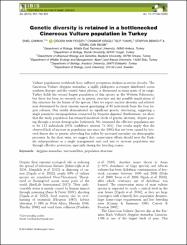Genetic diversity is retained in a bottlenecked Cinereous Vulture population in Turkey

Göster/
Erişim
info:eu-repo/semantics/closedAccessTarih
2019Yazar
Cakmak, EmelPeksen, Cigdem Akin
Kirazli, Cihangir
Yamac, Elif
Bensch, Staffan
Bilgin, Cemal Can
Üst veri
Tüm öğe kaydını gösterÖzet
Vulture populations worldwide have suffered precipitous declines in recent decades. the Cinereous Vulture Aegypius monachus, a highly philopatric scavenger distributed across southern Europe and the central Asian plateau, is threatened in many parts of its range. Turkey holds the second largest population of this species in the Western Palaearctic, but there has been no research on its genetic structure and the possible implications of this structure for the future of the species. Here we report nuclear diversity and relatedness determined by short tandem repeat genotyping of 81 individuals from the four largest colonies. Our results demonstrated no significant genetic structuring, suggesting a single panmictic metapopulation connected by frequent dispersal. Furthermore, we show that the study population has retained moderate levels of genetic diversity, despite passing through a recent demographic bottleneck. We estimated the effective population size to be 112 individuals (95% confidence interval 74-201). Our results imply that the observed lack of increase in population size since the 1990s has not been caused by lowered fitness due to genetic inbreeding but rather by increased mortality via demographic processes. in the short term, we suggest that conservation efforts should treat the Turkish subpopulations as a single management unit and aim to increase population size through effective protection, especially during the breeding season.

















